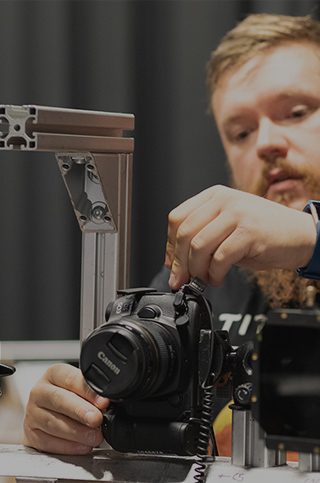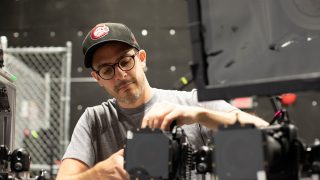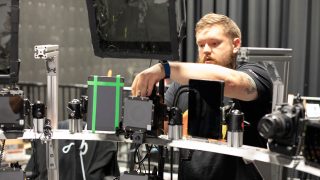開発者の声 – サッカー界のスター選手をスキャン
Sam MynottとPaul Bouletは世界中を飛び回り、サッカー界のトップに君臨するスタープレーヤーの特徴をモーションキャプチャーで取得しています

「FIFA 19」では、新たなチャンピオンが生まれ、夢が実現し、そしてUEFA Champions Leagueの舞台でレジェンドが誕生します。世界中の注目を集める大会の熱気を伝えるために、EA Vancouverのデータ収集スペシャリストのSam MynottとモーションキャプチャーシステムのスペシャリストであるPaul Bouletは世界中を旅して、スタープレーヤーの特徴データを収集しています。彼ら自身とEA Motion Capture Studioについて聞いてみましょう。
まず最初に、自己紹介をお願いします。
Paul: Paul Bouletです。Electronic Artsでは4年間働いています。中学卒業後に3Dモデリングとアニメーションを学び、その技術を生かしてEAのMotion Capture Studioで働くようになりました。
Sam: Sam Mynottです。2006年からMotion Capture Studioで働いています。

「試行錯誤を繰り返して効率とチームワークを向上させています」
データ収集スペシャリスト、Sam Mynott
「FIFA」では世界中のスターをスキャンしたとのことですが、そもそもどのようにしてこの仕事に就いたのでしょうか。
Paul: 学校を卒業してすぐにモーションキャプチャーアシスタントの職を得たのは幸運でした。最初は短期契約でしたが、自分の力を最大限に発揮できるように一生懸命働きました。おかげで周囲からの評価も高く、再契約してもらうことができました。
Sam: 2006年のことです。当時はテレビ業界について学んでいて、動画編集か映画製作に関わりたいと思っていました。そんな時にCraigslistで求人を見つけたので応募したところ、面接の機会をもらえました。モーションキャプチャーと3Dスキャニングについては、すべて仕事を通じて学びました。
世界中のクラブを訪ねて選手をスキャンして回るそうですね。長期間の出張となるわけですが、どのように感じていますか?
Sam: 仕事で旅ばかりしているので、もう慣れてしまいました。Paulも私も昨年は4ヶ月以上も出張していた計算になります。なかなか家には帰ることができませんが、世界中の国々を見て回れてよかったと思います。

「写真に関する知識とスキャニングソフトウェアへの理解、そして画像をどのように利用するのかを把握することが、最も重要です。」
モーションキャプチャースペシャリスト、Paul Boulet
顔のスキャンについて教えてもらえますか?
Paul: 顔をスキャンする技術には写真測量法というプロセスが用いられています。写真を使って顔のマップを作成する技術です。私達が撮った選手の写真を使って、バンクーバーにいるチームが頭部から作成を始めます。画像は特別なプログラムにかけられます。写真1枚1枚を細かく見るもので、ソフトウェアは「一意識別子」というものを検出していきます。例えば、シミや毛穴などの各個人でことなる特徴と呼べるものです。すべての画像でこの比較作業が終わると、ソフトウェアが選手の顔のマップを作成します。そしてこれらの一意識別子とマップを使って3D表現が作成されます。
実際に撮ったスキャン画像は少し粗いものなので、アーティストによって修正されます。アーティストは選手の写真を参考にしながら、なめらかさを出すように修正していきます。そしてモデリングとテクスチャパスと組み合わせて、3Dの頭部が実物に可能な限り近づけるようにしています。
スキャンする際には特別なスキルが必要ですか?
Paul: 写真に関する知識とスキャニングソフトウェアへの理解、そして画像をどのように利用するのかを把握することが、最も重要です。
Sam: 使用する特別なカメラと専用のスキャニングソフトウェアについての知識は非常に重要です。カメラ位置に関する深い知識やワークフローに関しては、実際に経験して身につけていきます。それから、細部まで徹底してこだわることも重要です。照準はピッタリと正確に合わせて、被写界深度はとても浅く設定しなければなりません。試行錯誤を繰り返して効率とチームワークを向上させて身につけていきます。
各クラブに機材を輸送するのは大変ではないですか?
Paul: そりゃもう大変です!機材を入れるケースは11もあって、重量は全部で250キログラムにもなってしまいます。カメラ、小型PC、鉄製のリグ、照明にスタンドに…
この分野で長年働いてこられました。駆け出しの頃と比べてスキャンに関して、どのような進歩があったのでしょうか?
Sam: リグが小さくなりましたし、カメラやキャプチャーソフトもすごく進歩しました。数年前までは幕を張って、360度フルにキャプチャーできるリグをその内側に設置し、外側には照明を設置して柔らかい光を拡散させて撮影していました。今では180度対応のリグを使っていて、そのような幕も照明も必要なくなりました。代わりに偏光照明を使用することでスキャンの質が向上し、ゲームエンジンによる光の表現にもうまくマッチするようになりました。使用する機材の数が減ったことで、仕事の効率も良くなりました。限られた時間でたくさんのチームを撮影できますし、撮影にかかる労力も少なくなりましたね。
選手の顔をスキャンすることで「FIFA」シリーズにどのような影響があると思いますか?
Paul: 一番大きな影響は、リアルな映像が楽しめて没入感が増すことではないかと思います。実物とはかけ離れた選手を操作したい人はおそらくいないと思います。
仕事を進める中で、お気に入りの選手をスキャンする機会はありましたか?
Sam: 私はカナダ人でホッケーが好きなので、実はサッカーは少しかじった程度のファンといったところでしょうか。でも選手に会うのは本当にクールでした。選手自身も「FIFA」をプレイしているので、自分がスキャンされることに興奮していましたね。
プロサッカー選手との仕事はどうでしたか?彼らは実際に「FIFA」をプレイしているわけで、どんなゲームか知っています。プレッシャーも感じるのではないですか?
Paul: サッカー選手とこうやって関われるのは素晴らしいと思います。多くの選手が「FIFA」をプレイしていますが、ゲーム内の顔や能力値について尋ねてきた選手はごくわずかでした。ゲームに自分の顔が使用されて、そのスキャンを体験することに大興奮する選手ばかりです。
Sam: サッカー選手は仕事をする上でも素晴らしい人ばかりで、私達のことも尊敬してくれるのです。多くの選手が「FIFA」をプレイし、自分がゲームに登場することを喜んでくれるので、仕事もスムーズに進めることができます。私達はゲームに関わる巨大なチームの一員に過ぎません。ですから、特別大きなプレッシャーを感じることもありませんね。
長い旅の後、カナダに戻ってきたら何をしたいですか?
Paul: 自分のベットで寝て、家族や友達と会いたいですね。我が家がやっぱり一番ですから。
Sam: 我が家の味を堪能して、自分のベットで眠りたいですね。
素晴らしいゲームの制作に必要なスキルや経験をお持ちですか?当社の採用情報をこちらから確認してください。
______________________
EAからのニュースやお知らせについては、ブログや on Twitter、Facebookの公式アカウントでご確認ください。

